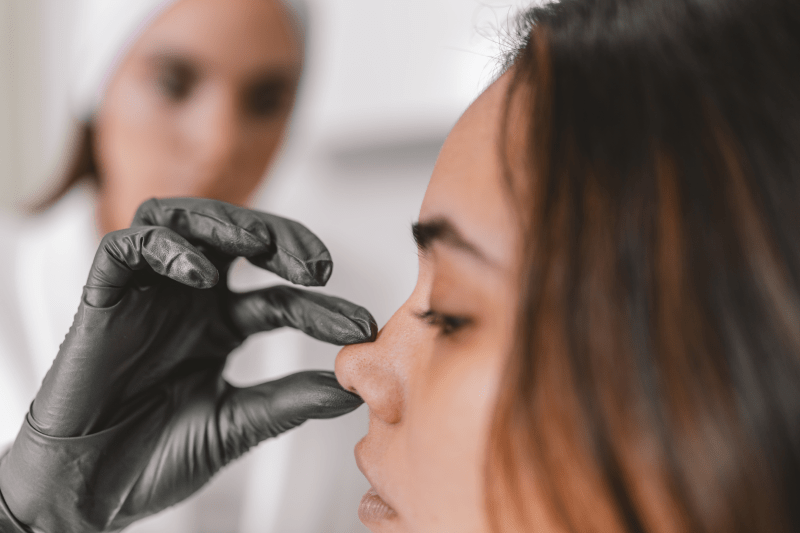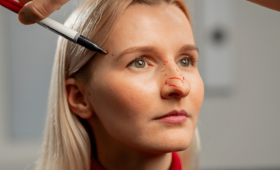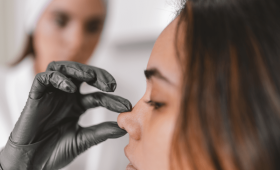What is Rhinoplasty?
Rhinoplasty, or a nose job, is a surgical procedure performed to change the shape of the nose or to improve its respiratory functions. This surgery can be done for aesthetic purposes such as reducing the size of the nose, lifting or lowering the nasal tip, straightening the hump on the bridge of the nose, or changing the size of the nostrils.
It is also applied to resolve functional problems like a deviated septum (curvature of the middle partition of the nose) that can obstruct breathing. The procedure is typically performed under general anesthesia and takes 1 to 3 hours. This surgery allows a person to have a nose that is more in harmony with their facial features and looks more natural.
Who Can Get a Rhinoplasty?
The most suitable candidates for rhinoplasty are individuals who have completed their physical development. This is generally accepted as being 17 years of age or older for women, and 18 years of age or older for men. Candidates should be in good general health and have no conditions that would prevent them from receiving anesthesia.
Most importantly, patients must have realistic expectations from the surgery. Before the operation, the patient’s facial structure and nose shape are examined in detail, and they are informed about the possible outcomes. In addition to aesthetic concerns, patients who have functional problems like difficulty breathing are also suitable candidates for this surgery.
How is a Rhinoplasty Performed?
Rhinoplasty is performed using two main techniques: open or closed. In the open technique, a small incision is made between the nostrils (on the columella), and the nasal skin is lifted to allow direct access to the cartilage and bone structures. This method provides the surgeon with a wider field of view. In the closed technique, all incisions are made inside the nose, leaving no visible external scar. During the surgery, the nasal hump can be corrected, the tip cartilages can be reshaped, or the nostrils can be reduced. The surgery is planned on an individual basis, depending on the patient’s nose structure and the desired outcome.
How Long Does the Surgery Take?
The duration of a rhinoplasty surgery varies depending on the complexity of the procedure. Simpler operations, such as just correcting the nasal tip, take less time, while operations that require extensive changes to the bone and cartilage structures can take longer. On average, a rhinoplasty surgery is completed in 1 to 3 hours. This duration does not include the time for anesthesia preparation and the post-operative recovery. The surgeon’s experience and the technique used are also important factors that influence the length of the operation.
Is Pain Felt After the Surgery?
The pain felt after a rhinoplasty is generally not as severe as is commonly believed. During the post-operative period, patients may experience mild to moderate discomfort. This discomfort is easily managed with painkillers prescribed by the doctor. Rather than severe pain, a feeling of fullness, pressure, or a dull ache in the nose is more common. Bruising and swelling are also a natural part of this process. The first few days after the surgery may be the most uncomfortable, but this condition quickly improves.
What is Tip Plasty?
Tip plasty is an aesthetic operation that focuses only on the nasal tip. Unlike a full rhinoplasty, the nasal bones are not altered. This procedure is ideal for those who want to correct the shape, size, or appearance of their nostrils. The surgery is performed by reshaping the cartilage at the tip of the nose. Since it requires fewer incisions and less intervention, the recovery process is faster, and the risk of bruising and swelling is lower. Tip plasty is suitable for patients who are happy with their overall nasal structure but only want a change to the tip.
What Should Be Considered Before Surgery?
Things to consider before a rhinoplasty are critical for the success of the surgery. The use of aspirin and other medications that can have a blood-thinning effect must be stopped at least two weeks before the procedure. Smoking and alcohol consumption should also be stopped before the surgery as they can negatively affect the healing process. The surgeon must be informed about any regular medications or chronic illnesses. A general health check is performed before the surgery to determine if there is any condition that would prevent anesthesia.
Is Rhinoplasty a Permanent Solution?
Yes, rhinoplasty is a permanent solution. The nose shape obtained with the surgery may change with the natural aging process, just like other facial features, but the basic form provided by the surgery is preserved. The results of the surgery are generally permanent for life. Therefore, it is very important for patients to understand their expectations from the surgery and for these expectations to be realistic. The complete reduction of swelling and the emergence of the final shape may take several months, or even a year.
Do Scars Remain After the Surgery?
The presence of scars after a rhinoplasty depends on the technique used. In the closed technique, all incisions are made inside the nose, so there is no visible external scar. In the open technique, a small incision of about 3-4 mm is made in the area between the nostrils called the columella. This scar fades over time and becomes almost invisible. Thanks to modern surgical techniques, scars are minimized and are generally not noticeable.
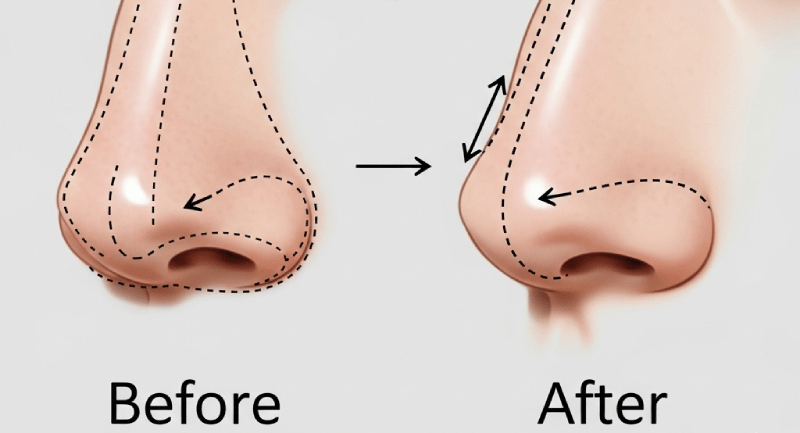
When Does the Swelling Go Down After Surgery?
The swelling that occurs after surgery is a natural part of the healing process. Most of the swelling goes down within the first month. However, the complete disappearance of the remaining minor swelling and the nose taking its final shape can take between 6 months and 1 year. The rate at which the swelling subsides depends on the patient’s skin type and the extent of the surgery. Applying ice during the first few weeks and keeping the head elevated can help the swelling go down faster. It is important for patients to be patient and give the healing process time.
Are Tampons Used in Nose Surgery?
Today, instead of the old, painful, and difficult-to-remove tampons, modern rhinoplasty surgeries generally use silicone or air-channelled tampons. These tampons make breathing easier after the surgery and are much more comfortable to remove. In some cases, the surgeon may also choose not to use any tampon. Tampons are usually removed 1-3 days after the surgery. A slight seepage from the nose during this process is considered normal.
What is the Recovery Process Like?
Although the recovery process varies for each patient, it follows a general course. Bruising and swelling reach their peak in the first few days. The cast or splint placed on the nose is removed within the first week. The majority of the bruising disappears within two weeks. For the first month after the surgery, heavy exercises and activities that may cause an impact to the nose should be avoided. The nose can take its final shape within 6 months to 1 year. Following the doctor’s advice is very important during this process.
What Factors Affect the Price of the Surgery?
Rhinoplasty prices vary depending on many factors. These include the surgeon’s experience, the quality of the hospital where the surgery will be performed, the type of anesthesia used, and the complexity of the operation. Prices also vary according to the type of operation determined by the patient’s nose structure and the desired result. Therefore, the most accurate approach is to have a face-to-face consultation with a doctor to get a definitive price.
When Can I Go Back to Work After Surgery?
The time to return to work after a rhinoplasty depends on the type of work and the person’s recovery speed. Most patients can return to work a week after the surgery. However, it should be kept in mind that there will be a cast or splint on the nose, and swelling will be visible during the first few weeks. This period may be longer for those who work in a physically demanding job.
What is Revision Rhinoplasty?
Revision rhinoplasty is a second surgery performed on patients who have previously had a rhinoplasty but are not satisfied with the result or have experienced a complication. It aims to correct the problems caused by the first surgery. Revision surgeries can be more challenging and complex than the first surgery because the nasal tissues have already undergone changes. For this reason, revision rhinoplasty is usually performed by more experienced surgeons who specialize in this field.
How Should Glasses Be Used After Surgery?
It is not recommended to use glasses for the first 6 weeks after a rhinoplasty. The pressure applied by the glasses frames on the nasal bridge can damage the newly shaped bone and cartilage structures and negatively affect healing. In this period, using contact lenses is a safer alternative. If using glasses is unavoidable, lightweight or rimless models that do not put pressure on the nasal bridge should be preferred. Your surgeon will give you the most accurate information on when you can start using glasses.
Is Non-Surgical Rhinoplasty Possible?
Yes, non-surgical rhinoplasty is usually done using dermal fillers. This method is used to correct minor irregularities, asymmetry, or a drooping nasal tip. It is not a permanent solution, and its effect lasts for 12 to 18 months. Unlike surgery, this procedure cannot reduce the size of the nose or fix serious hump problems. However, it is a less costly and faster option.
How Is the Nose Shape Decided?
When deciding on the nose shape, many factors are taken into consideration, such as the patient’s facial features, gender, age, and ethnic background. The surgeon analyzes the patient’s existing nasal structure and uses computer simulations to show the possible results after the surgery. The patient and the doctor decide together on the most suitable and natural-looking nose shape. The goal is to achieve a nose that is most harmonious and looks natural with the person’s face.
What is the Best Season for Surgery?
The most suitable season for a rhinoplasty depends on the patient’s personal preferences and lifestyle. While the summer months are often preferred due to the holiday season, the winter months can also be suitable for the recovery process due to the colder weather. Since sun exposure should be avoided after the surgery, autumn or winter, when the sun is less intense, may provide a more comfortable recovery process.
How Should Nutrition Be After Surgery?
In the first few days after the surgery, soft, warm, and easy-to-chew foods should be consumed. Very hot or very cold foods should be avoided, as they can cause discomfort in the surgical area. Drinking plenty of water and reducing salt intake helps the swelling go down faster. Foods rich in protein and vitamins should be preferred to support healing.
Does Rhinoplasty Vary by Gender?
Yes, rhinoplasty differs by gender. For men, a straighter, more prominent, and more humped nasal structure is preferred, while for women, a smaller, upturned, and soft-featured nose is aimed for. The purpose of the surgery is to create a nose that is compatible with the person’s gender-specific facial features and looks natural.
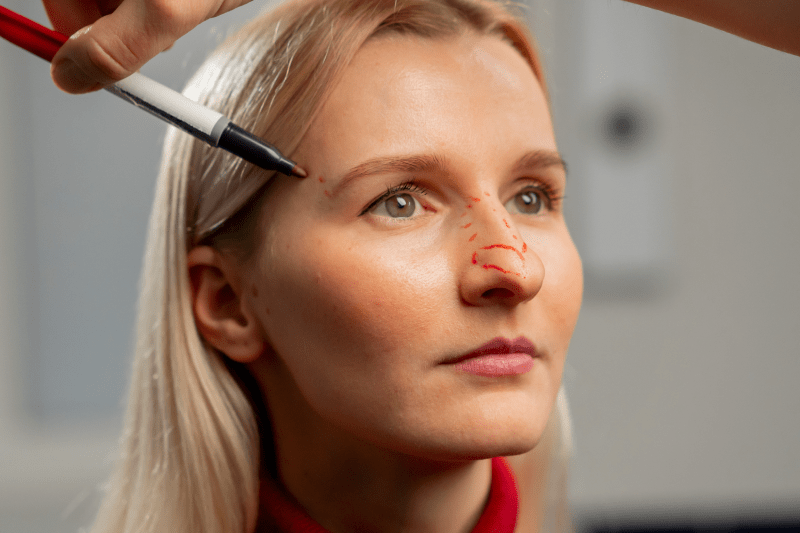
When Can I Start Exercising After Surgery?
It is recommended to wait at least one month before starting heavy sports and exercises after the surgery. In the first two weeks, only activities like light walking can be done. Since the nose will be very sensitive to impacts, contact sports (basketball, football, etc.) should be completely avoided. This period is important to give the body time for the nose to fully heal and take its final shape.
Is Rhinoplasty Performed Under General Anesthesia?
Rhinoplasty is generally performed under general anesthesia. This ensures that the patient is completely asleep during the operation and does not feel any pain. General anesthesia allows the surgeon to perform the operation more comfortably and in a controlled manner. The anesthesiologist decides on the most suitable anesthesia method by considering the patient’s general health condition.
Is There an Improvement in Breathing After Surgery?
During a rhinoplasty, structural problems such as a deviated septum that obstruct breathing inside the nose can also be corrected. This procedure is called septorhinoplasty. In this way, both an aesthetic appearance is achieved and the patient’s breathing quality is significantly improved. This dual-purpose surgery provides a solution to patients’ physical and aesthetic problems.
What Are the Psychological Effects of Rhinoplasty?
Rhinoplasty can increase a person’s self-confidence and positively affect their social life. Especially for people who are psychologically distressed by their noses, a happier and more self-confident life can be achieved after the surgery. Having a nose that is more compatible and aesthetic with the person’s face can improve their overall quality of life and social interactions.
When Is the Best Time for Revision Rhinoplasty?
The most suitable time for a revision rhinoplasty is at least 1 year after the first surgery. This period is necessary for the swelling in the nose to completely go down and for the tissues to heal. This waiting period allows the surgeon to evaluate the nasal structure more accurately. Rushing into a second surgery can lead to unwanted results.
How Should Nose Care Be Done After Surgery?
Nose care after surgery is one of the most important parts of the healing process. It is important to clean the inside of the nose using nasal sprays or solutions recommended by your doctor. The nose should not be blown, it should be protected from impacts, and regular check-ups should not be neglected. This care reduces the risk of infection and supports healing.
Is Massage Necessary After Surgery?
After the surgery, nose massage may be necessary as recommended by your doctor. These massages can help the swelling go down faster and the nose shape settle. However, these massages should be done with special techniques that your doctor will teach you and with their approval. Improper massages can harm the nose.
Is There an Age Limit for Rhinoplasty?
Yes, the minimum age limit for a rhinoplasty is the completion of nose and facial development. This is generally around 17 years of age for women and 18 years of age for men. The upper age limit is determined by the patient’s general health status and their ability to receive anesthesia. People who do not have chronic diseases and are in good general health can have this surgery even at an advanced age.
In Which Countries Can I Get Rhinoplasty ?
Countries that offer the highest quality treatments in rhinoplasty surgery are the United Kingdom, Germany and Turkey. The most affordable treatments are again in Turkey,Lithuania, Czech Republic and Croatia. It is also important to get the treatments at an affordable price, where it is important to get quality treatments. For this reason, the right decision should be made in choosing a country.
In Which Countries Can I Get Cheap Rhinoplasty ?
In most of the countries with low living costs, it is very easy to have rhinoplasty surgery at a very low cost. However, the important thing is to get successful and quality treatments at an affordable price. If you receive an unsuccessful treatment, it will be very expensive to have this poor outcome treated.
Is It Risky To Get Cheap Rhinoplasty ?
In cheap countries, it is important that the products used in surgical operations are of high quality. As a result, your nose will be opened and the operation will be performed. For this reason, the preferred hospital and clinic is very important. This also varies according to the preferred country. Therefore, receiving cheap treatment has risks in terms of quality. The nose may not be corrected as expected. Infection cannot be prevented. Persistent bleeding or nerve problems may occur. For this reason, it is also important that the country to be preferred while receiving cheap treatment is a country that provides quality treatment.
Lithuania, Czech Republic and Croatia Successful In Rhinoplasty ?
These countries are famous for providing cheap treatment, but the number of successful treatments is unknown. With a simple logic, when researching rhinoplasty treatments received in these countries, you will see that they stand out only with their prices. Whereas, perhaps they would have been more reliable if they had shared successful treatments and their prices. The achievements that are not included in any clinic in the country also leave a dilemma about the quality of the treatment received in the country.
What Makes Turkey Successful?
Turkey is one of the leading names in health tourism. The fact that Turkey has made its name known so much is due to its devoted and successful treatment. Clinics in Turkey use first quality products during the operation and always keep the room used during the treatment sterile. This increases the success rate of the applied surgery. The low cost of living in the country and the high dollar rate also allow you to get these surgeries at a very affordable price.
Considerations When Choosing A Clinic
There are some points to consider when choosing a clinic in Turkey or in a different country. For example, the previous treatments of the clinic or hospital should be able to be shared with patients in a transparent way. Secondly, in Turkey, there are health tourism authorization certificates issued by the state to some clinics. These mean that that clinic provides successful, quality treatments for tourists. For this reason, if you are considering getting treatment in Turkey, you can ask the clinic if they have this document.
Rhinoplasty Costs Abroad
It differs according to the country you prefer. Average prices start from 1500 euros and can vary up to 10k euros.
Rhinoplasty Cost In Turkey 2025
Turkey offers reasonable price advantages in many areas. Prices for rhinoplasty surgery are presented in packages. It is 2550 euros.
1 night hospital stay + examination and tests + 6 days hotel accommodation + post-operative examinations + hotel, airport and hospital transfers are included in the package.
